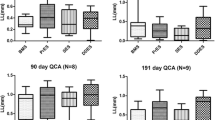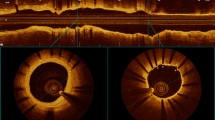Abstract
Purpose
To date no direct experimental comparison between the CYPHER-Select and TAXUS-Express stents is available. Therefore, we investigated late in-stent stenosis, thrombogenicity, and inflammation, comparing the CYPHER-Select, TAXUS-Express, and custom-made cobalt chromium Polyzene-F nanocoated stents (CCPS) in the minipig coronary artery model.
Methods
The three stent types were implanted in the right coronary artery of 30 minipigs. The primary endpoint was in-stent stenosis assessed by quantitative angiography and microscopy. Secondary endpoints were inflammation and thrombogenicity evaluated by scores for inflammation and immunoreactivity (C-reactive protein and transforming growth factor beta). Follow-up was at 4 and 12 weeks.
Results
Stent placement was successful in all animals; no thrombus deposition occurred. Quantitative angiography did not depict statistically significant differences between the three stent types after 4 and 12 weeks. Quantitative microscopy at 4 weeks showed a statistically significant thicker neointima (p = 0.0431) for the CYPHER (105.034 ± 62.52 μm) versus the TAXUS (74.864 ± 66.03 μm) and versus the CCPS (63.542 ± 39.57 μm). At 12 weeks there were no statistically significant differences. Inflammation scores at 4 weeks were significantly lower for the CCPS and CYPHER compared with the TAXUS stent (p = 0.0431). After 12 weeks statistical significance was only found for the CYPHER versus the TAXUS stent (p = 0.0431). The semiquantitative immunoreactivity scores for C-reactive protein and transforming growth factor beta showed no statistically significant differences between the three stent types after 4 and 12 weeks.
Conclusions
The CCPS provided effective control of late in-stent stenosis and thrombogenicity in this porcine model compared with the two drug-eluting stents. Its low inflammation score underscores its noninflammatory potential and might explain its equivalence to the two DES.



Similar content being viewed by others
References
Moliterno DJ (2005) Healing Achilles: Sirolimus versus paclitaxel. N Engl J Med 353:724–727
Farb A, Boam AB (2007) Stent thrombosis redux: The FDA perspective. N Engl J Med 356:984–987
Camenzind E, Steg PG, Wijns W (2007) Stent thrombosis late after implantation of first-generation drug-eluting stents: A cause for concern. Circulation 115:1440–1455
Maisel WH (2007) Unanswered questions: Drug-eluting stents and the risk of late thrombosis. N Engl J Med 356:981–984
Virmani R, Liistro F, Stankovic G, et al. (2002) Mechanism of late in-stent restenosis after implantation of a paclitaxel derivate-eluting polymer stent system in humans. Circulation 106:2649–2651
Tur DR, Korshak VV, Vinogradova SV, et al. (1986) Effects of biological medium on the properties of poly[bis(trifluoroethoxy)phosphazene]. Acta Polym 37:203–208
Vinogradova SV, Tur DR, Vasnev VA (1998) Open-chain poly(organophosphazenes). Synthesis and properties. Russian Chem Rev 67:515–534
Welle A, Grunze M, Tur D (1998) Plasma protein adsorption and platelet adhesion on poly[bis(trifluoroethoxy)phosphazene] and reference material surfaces. J Colloid Interface Sci 197:263–274
Richter GM, Stampfl U, Stampfl S, et al. (2005) A new polymer concept for coating of vascular stents using PTFEP (poly(bis(trifluoroethoxy)phosphazene) to reduce thrombogenicity and late in-stent stenosis. Invest Radiol 40:210–218
Satzl S, Henn C, Christoph P, et al. (2007) The efficacy of nanoscale poly[bis(trifluoroethoxy) phosphazene] (PTFEP) coatings in reducing thrombogenicity and late in-stent stenosis in a porcine coronary artery model. Invest Radiol 42:303–311
Bayne K (1998) Developing guidelines on the care and use of animals. Ann N Y Acad Sci 862:105–110
Schwartz RS, Edelman ER, Carter A, et al. (2002) Drug-eluting stents in preclinical studies: Recommended evaluation from a consensus group. Circulation 106:1867–1873
Schwartz RS, Huber KC, Murphy JG, et al. (1992) Restenosis and the proportional neointimal response to coronary artery injury: Results in a porcine model. J Am Coll Cardiol 19:267–274
Kornowski R, Hong MK, Tio FO, et al. (1998) In-stent restenosis: contributions of inflammatory responses and arterial injury to neointimal hyperplasia. J Am Coll Cardiol 31:224–230
Finis K, Sultmann H, Ruschhaupt M, et al. (2006) Analysis of pigmented villonodular synovitis with genome-wide complementary DNA microarray and tissue array technology reveals insight into potential novel therapeutic approaches. Arthritis Rheum 54:1009–1019
Hong MK, Kornowski R, Bramwell O, et al. (2001) Paclitaxel-coated Gianturco-Roubin II (GR II) stents reduce neointimal hyperplasia in a porcine coronary in-stent restenosis model. Coron Artery Dis 12:513–515
Drachman DE, Edelman ER, Seifert P, et al. (2000) Neointimal thickening after stent delivery of paclitaxel: Change in composition and arrest of growth over six months. J Am Coll Cardiol 36:2325–2332
Suzuki T, Kopia G, Hayashi S, et al. (2001) Stent-based delivery of sirolimus reduces neointimal formation in a porcine coronary model. Circulation 104:1188–1193
Carter AJ, Aggarwal M, Kopia GA, et al. (2004) Long-term effects of polymer-based, slow-release, sirolimus-eluting stents in a porcine coronary model. Cardiovasc Res 63:617–624
Farb A, Heller PF, Shroff S, et al. (2001) Pathological analysis of local delivery of paclitaxel via a polymer-coated stent. Circulation 104:473–479
Finn AV, Kolodgie FD, Harnek J, et al. (2005) Differential response of delayed healing and persistent inflammation at sites of overlapping sirolimus- or paclitaxel-eluting stents. Circulation 112:270–278
Heldman AW, Cheng L, Jenkins GM, et al. (2001) Paclitaxel stent coating inhibits neointimal hyperplasia at 4 weeks in a porcine model of coronary restenosis. Circulation 103:2289–2295
Gaspardone A, Versaci F, Tomai F, et al. (2006) C-Reactive protein, clinical outcome, and restenosis rates after implantation of different drug-eluting stents. Am J Cardiol 97:1311–1316
Chamberlain J, Gunn J, Francis SE, et al. (2001) TGFbeta is active, and correlates with activators of TGFbeta, following porcine coronary angioplasty. Cardiovasc Res 50:125–136
Lagerqvist B, James SK, Stenestrand U, et al. (2007) Long-term outcomes with drug-eluting stents versus bare-metal stents in Sweden. N Engl J Med 356:1009–1019
Luscher TF, Steffel J, Eberli FR, et al. (2007) Drug-eluting stent and coronary thrombosis: Biological mechanisms and clinical implications. Circulation 115:1051–1058
Virmani R, Guagliumi G, Farb A, et al. (2004) Localized hypersensitivity and late coronary thrombosis secondary to a sirolimus-eluting stent: Should we be cautious? Circulation 109:701–705
Richter GM, Palmaz JC, Noeldge G, et al. (1999) Relationship between blood flow, thrombus, and neointima in stents. J Vasc Interv Radiol 10:598–604
Virmani R, Kolodgie FD, Farb A, et al. (2003) Drug eluting stents: are human and animal studies comparable? Heart 89:133–138
Acknowledgments
Funding sources. This study was sponsored in part by CeloNova BioSciences., Inc. Newnan, GA, USA.
Financial disclosures. U.S., R.L.-B, and G.M.R. have sponsored research agreements with CeloNova BioSciences, Inc., Newnan, GA, USA. G.M.R. has served as consultant to CeloNova BioSciences, Inc., Newnan, GA, USA.
Author information
Authors and Affiliations
Corresponding author
Rights and permissions
About this article
Cite this article
Radeleff, B., Thierjung, H., Stampfl, U. et al. Restenosis of the CYPHER-Select, TAXUS-Express, and Polyzene-F Nanocoated Cobalt-Chromium Stents in the Minipig Coronary Artery Model. Cardiovasc Intervent Radiol 31, 971–980 (2008). https://doi.org/10.1007/s00270-007-9243-y
Received:
Revised:
Accepted:
Published:
Issue Date:
DOI: https://doi.org/10.1007/s00270-007-9243-y




